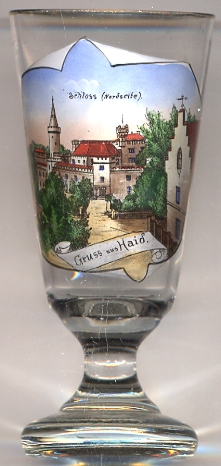

|
| ČESKÁ REPUBLIKA | CZECH REPUBLIC |
| Plzeňský kraj | Plzeň region |
| Okres: Tachov |
Bor (in German: Haid) is situated at an elevation of 472 m in western Bohemia, about 30 km west of Plzeň and about 14 km southeast of the district town Tachov. The municipality has a poppulation of about 4,150 (2014) and includes the localities Bezděkov (Wesigau), Boječnice (Woschnitz), Bor (Haid), Borovany (Turban), Čečkovice (Eschowitz), Damnov (Damnau), Doly (Tholl) with Lukavice (Lukawetz), Hlupenov (Neuhäusl), Holostřevy (Hollezrieb), Kosov (Gossau), Kurojedy (Juratin), Lhota (Elhotten), Lužná, Málkovice (Malkowitz), Malovice (Mallowitz), Muckov (Mutzken), Nová Hospoda (Neuwirtshaus I), Nový Dvůr (Neuhof), Ostrov (Ostrau), Skviřín (Speierling), Velká Ves (Sinzendorf), and Vysočany (Weschekun).
 The village was founded prior to 1250 on the route from Stříbro to the border fort of Přimda.
The local stronghold was first mentioned in 1263 under the German name Haid and in Czech Bor. In the 14th century, the lords of Schwanberg
(Švamberk), earlier burgraves of Přimda (Pfraumberg), who in the 14th century took residence in the castle of Krasíkov (Schwanberg), were the owners of
Haid/Bor.
In 1654, Haid/Bor was chartered as a town. Since 1720 Haid was in possession of the princes Löwenstein-Wertheim.
After World War II, the princes Löwenstein-Wertheim were dispossessed and the German population was expelled.
The village was founded prior to 1250 on the route from Stříbro to the border fort of Přimda.
The local stronghold was first mentioned in 1263 under the German name Haid and in Czech Bor. In the 14th century, the lords of Schwanberg
(Švamberk), earlier burgraves of Přimda (Pfraumberg), who in the 14th century took residence in the castle of Krasíkov (Schwanberg), were the owners of
Haid/Bor.
In 1654, Haid/Bor was chartered as a town. Since 1720 Haid was in possession of the princes Löwenstein-Wertheim.
After World War II, the princes Löwenstein-Wertheim were dispossessed and the German population was expelled.
 Bor castle
Bor castle
Another glass from this collection is a souvenir from Nový Bor (previous German name:
Haida) in northern Bohemia.
[https://de.wikipedia.org/wiki/Bor_u_Tachova]
![[scale]](lineal.jpg)